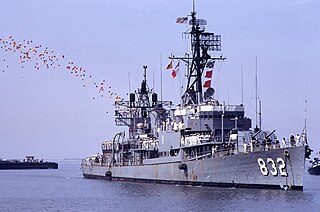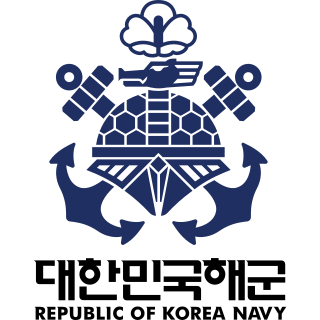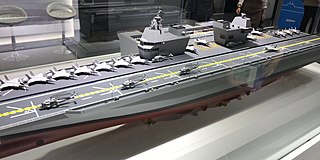
In naval terminology, a destroyer is a fast, maneuverable, long-endurance warship intended to escort larger vessels in a fleet, convoy, or carrier battle group and defend them against a wide range of general threats. They were originally conceived in 1885 by Fernando Villaamil for the Spanish Navy as a defense against torpedo boats, and by the time of the Russo-Japanese War in 1904, these "torpedo boat destroyers" (TBDs) were "large, swift, and powerfully armed torpedo boats designed to destroy other torpedo boats". Although the term "destroyer" had been used interchangeably with "TBD" and "torpedo boat destroyer" by navies since 1892, the term "torpedo boat destroyer" had been generally shortened to simply "destroyer" by nearly all navies by the First World War.

A frigate is a type of warship. In different eras, the roles and capabilities of ships classified as frigates have varied somewhat.

A corvette is a small warship. It is traditionally the smallest class of vessel considered to be a proper warship. The warship class above the corvette is that of the frigate, while the class below was historically that of the sloop-of-war.

The Gearing class was a series of 98 destroyers built for the U.S. Navy during and shortly after World War II. The Gearing design was a minor modification of the Allen M. Sumner class, whereby the hull was lengthened by 14 ft (4.3 m) at amidships, which resulted in more fuel storage space and increased the operating range.

Destroyer escort (DE) was the United States Navy mid-20th-century classification for a 20-knot warship designed with the endurance necessary to escort mid-ocean convoys of merchant marine ships.

The Fletcher class was a class of destroyers built by the United States during World War II. The class was designed in 1939, as a result of dissatisfaction with the earlier destroyer leader types of the Porter and Somers classes. Some went on to serve during the Korean War and into the Vietnam War.

The Republic of Korea Navy, also known as the ROK Navy or South Korean Navy, is the naval warfare service branch of the South Korean armed forces, responsible for naval and amphibious operations. The ROK Navy includes the Republic of Korea Marine Corps, which functions as a branch of the Navy. The ROK Navy has about 70,000 regular personnel including 29,000 Republic of Korea Marines. There are about 140 commissioned ships in the ROK Navy. The naval aviation force consists of about 70 fixed-wing and rotary-wing aircraft. The ROK Marine Corps has about 300 tracked vehicles including assault amphibious vehicles.

Chungmugong Yi Sun-sin class destroyers are multipurpose destroyers of the Republic of Korea Navy. The lead ship of this class, ROKS Chungmugong Yi Sunsin, was launched in May 2002 and commissioned in December 2003. Chungmugong Yi Sun-sin-class destroyers were the second class of ships to be produced in the Republic of Korea Navy's destroyer mass-production program named Korean Destroyer eXperimental, which paved the way for the navy to become a blue-water navy. Six ships were launched by Hyundai Heavy Industries and Daewoo Shipbuilding & Marine Engineering in four years.

Charleston Naval Shipyard was a U.S. Navy ship building and repair facility located along the west bank of the Cooper River, in North Charleston, South Carolina and part of Naval Base Charleston.

The Sejong the Great-class destroyers, also known as KDX-III, are three guided-missile destroyers of the Republic of Korea Navy (ROKN).

The Gwanggaeto the Great-class destroyers, often called KDX-I, are destroyers, but are classified by some as frigates, operated by the Republic of Korea Navy. It was the first phase of ROKN's KDX program, in moving the ROK Navy from a coastal defence force to a blue-water navy.

USS Norris (DD-859) was one of 98 Gearing-class destroyers in the United States Navy during the end of World War II. Norris was active from 9 June 1945 to 4 December 1970. Although built too late to see action during the war, the ship served in the Pacific, Atlantic, Asiatic, and Mediterranean areas.

The RIM-66 Standard MR (SM-1MR/SM-2MR) is a medium-range surface-to-air missile (SAM), with a secondary role as an anti-ship missile, developed for the United States Navy (USN). A member of the Standard Missile family of weapons, the SM-1 was developed as a replacement for the RIM-2 Terrier and RIM-24 Tartar that were deployed in the 1950s on a variety of USN ships. The RIM-67 Standard (SM-1ER/SM-2ER) is an extended range version of this missile with a solid rocket booster stage.
The Republic of Korea Navy was founded on November 11, 1945 as Marine Defense Group after Korea was liberated from the Empire of Japan. The ROK Navy is the oldest service within the ROK Armed Forces. In 2015, the South Korean navy celebrated its 70th anniversary.

The Pohang-class PCC is the low-end complement of the high-low mix domestic naval construction plan of the Republic of Korea Navy under the 1st Yulgok Project (1974-1986) for the Republic of Korea Armed Forces. It was originally planned as a Batch II production of Donghae-class corvette, but many changes on overall design, notably applying the hull design of Ulsan-class frigate, reclassified the ship to its own class. The ship is designed for patrolling maritime border, including the Northern Limit Line, protecting the littoral zone, and combating the North Korean vessels.

The Chungbuk-class was a class of 7 destroyers, formerly the United States' Gearing-class destroyer, that were transferred to and commissioned by the Republic of Korea Navy. They entered service in 1972, with the last one being decommissioned in 2001.

ROKS Sejong the Great (DDG-991) is the lead ship of her class of guided missile destroyer built for the Republic of Korea Navy. She was the first Aegis-built destroyer of the service and was named after the fourth king of the Joseon dynasty of Korea, Sejong the Great.

The CVX is a class of aircraft carriers proposed for the Republic of Korea Navy. The class is follow-on from the previous Dokdo-class amphibious assault ships which prioritized amphibious capability, while the CVX will be designed for fixed wing and rotary wing operations instead, constituting a traditional aircraft carrier. The planned development of the class was formally announced and funded as part of the 2020~2024 Mid-Term Defense Plan (국방중기계획), published in December 2020. The Korean presidential administration that entered power in 2022 is not supportive of the CVX project, and it was not funded in the 2023 and 2024 defense budgets.

The Chungmuclass was a class of 3 destroyers in the Republic of Korea Navy. They entered service in 1963, with the last one being decommissioned in 1989.

The Daeguclass was a class of 2 destroyers by the Republic of Korea Navy. They entered service in 1973, with the last one being decommissioned in 1994.


















